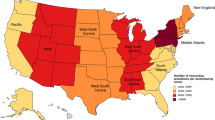Abstract
Objective
The purpose of this study is to identify the impact of demographic, socioeconomic, and clinical factors on congenital heart surgery outcomes.
Study Design
This retrospective cohort study included 234 congenital heart surgery patients from 2011 through 2015, in a racially/ethnically diverse metropolitan children’s hospital. Outcomes included length of stay (LOS), age at first echocardiogram, length of mechanical ventilation, and incidence of complications.
Results
Compared to others, black children underwent their first echocardiogram at a later age (median 23 versus 2 days, p = 0.014) and were more likely to be diagnosed with congenital heart disease in the emergency room (p = 0.026). Hispanic children were more likely to have major non-cardiac congenital anomalies (p = 0.045). Increased LOS during elective admissions was associated with higher surgical complexity (STAT category 4 and 5 Estimate 3.905 days, p = 0.001), compared to STAT category 1, and number of complications (Estimate = 2.306 days per complication, p < 0.001). Increased LOS in non-elective admissions was associated with the number of complex chronic conditions (Estimate = 15.446 days, p = 0.045) and the number of complications (Estimate = 11.591 days per complication, p < 0.001). However, in multivariate analysis, race and ethnicity was not associated with increased LOS or age at first echocardiogram.
Conclusion
In this diverse setting, race/ethnicity was not associated with increased LOS, age at first echocardiogram, length of ventilation, or complications. Surgical complexity, chronic conditions, and complications were associated with increased LOS. We discuss some interventions to reduce disparities in congenital heart surgery outcomes.

Similar content being viewed by others
References
DiBardino DJ, Pasquali SK, Hirsch JC, Benjamin DK, Kleeman KC, Salazar JD, et al. Effect of sex and race on outcome in patients undergoing congenital heart surgery: an analysis of the Society of Thoracic Surgeons Congenital Heart Surgery Database. Ann Thorac Surg. 2012;94(6):2054–60.
Oster ME, Strickland MJ, Mahle WT. Racial and ethnic disparities in post-operative mortality following congenital heart surgery. J Pediatr. 2011;159(2):222–6.
Chan T, Pinto NM, Bratton SL. Racial and insurance disparities in hospital mortality for children undergoing congenital heart surgery. Pediatr Cardiol. 2012;33(7):1026–39.
DeMone JA, Gonzalez PC, Gauvreau K, Piercey GE, Jenkins KJ. Risk of death for medicaid recipients undergoing congenital heart surgery. Pediatr Cardiol. 2003;24(2):97–102.
Benavidez OJ, Gauvreau K, Nido PD, Bacha E, Jenkins KJ. Complications and risk factors for mortality during congenital heart surgery admissions. Ann Thorac Surg. 2007;84(1):147–55.
Chan T, Lion KC, Mangione-Smith R. Racial disparities in failure-to-rescue among children undergoing congenital heart surgery. J Pediatr. 2015;166(4):812–8.e4.
Guller U. Surgical outcomes research based on administrative data: inferior or complementary to prospective randomized clinical trials? World J Surg. 2006;30(3):255–66.
Gavrielov-Yusim N, Friger M. Use of administrative medical databases in population-based research. J Epidemiol Community Health. 2014;68(3):283–7.
Shi L, Stevens G, Faed P, Tsai J. Rethinking vulnerable populations in the United States: an introduction to a general model of vulnerability. Harv Health Policy. 2008;9(1):43–8.
Aday LA. Health status of vulnerable populations. Annu Rev Public Health. 1994;15:487–509.
Andersen RM. Revisiting the behavioral model and access to medical care: does it matter? J Health Soc Behav. 1995;36(1):1–10.
Shi L, Stevens GD, Lebrun LA, Faed P, Tsai J. Enhancing the measurement of health disparities for vulnerable populations. J Public Health Manag Pract JPHMP. 2008;14(Suppl):S45–52.
Mellion K, Uzark K, Cassedy A, Drotar D, Wernovsky G, Newburger JW, et al. Health-related quality of life outcomes in children and adolescents with congenital heart disease. J Pediatr. 2014;164(4):781–8.e1.
California Children’s Services. California Children’s Services Program Overview [Internet]. [cited 2016 Aug 2]. Available from: http://www.dhcs.ca.gov/services/ccs/Pages/ProgramOverview.aspx.
Healthcare Cost and Utilization Project (HCUP) KID Notes [Internet]. [cited 2016 Jul 12]. Available from: https://www.hcup-us.ahrq.gov/db/vars/kidnote_multi.jsp.
Society of Thoracic Surgeons. The Society of Thoracic Surgeons Congenital Heart Surgery Database Data Collection Form Version 3.3 [Internet]. 2015 [cited 2016 Aug 2]. Available from: http://www.sts.org/sites/default/files/documents/CongenitalDCF_v3_3_NonAnnotated.pdf.
Feudtner C, Feinstein JA, Zhong W, Hall M, Dai D. Pediatric complex chronic conditions classification system version 2: updated for ICD-10 and complex medical technology dependence and transplantation. BMC Pediatr. 2014;14:199.
O’Brien SM, Clarke DR, Jacobs JP, Jacobs ML, Lacour-Gayet FG, Pizarro C, et al. An empirically based tool for analyzing mortality associated with congenital heart surgery. J Thorac Cardiovasc Surg. 2009;138(5):1139–53.
Gaies MG, Gurney JG, Yen AH, Napoli ML, Gajarski RJ, Ohye RG, et al. Vasoactive–inotropic score as a predictor of morbidity and mortality in infants after cardiopulmonary bypass. Pediatr Crit Care Med. 2010;11(2):234–8.
Faul F, Erdfelder E, Buchner A, Lang A-G. Statistical power analyses using G*Power 3.1: tests for correlation and regression analyses. Behav Res Methods. 2009;41(4):1149–60.
Bryant AS, Worjoloh A, Caughey AB, Washington AE. Racial/ethnic disparities in obstetrical outcomes and care: prevalence and determinants. Am J Obstet Gynecol. 2010;202(4):335–43.
Egbe AC, Mittnacht AJ, Nguyen K, Joashi U. Risk factors for morbidity in infants undergoing tetralogy of fallot repair. Ann Pediatr Cardiol. 2014;7(1):13–8.
Tabib A, Abrishami SE, Mahdavi M, Mortezaeian H, Totonchi Z. Predictors of prolonged mechanical ventilation in pediatric patients after cardiac surgery for congenital heart disease. Res Cardiovasc Med [Internet]. 2016 Jul 20 [cited 2017 Feb 16];5(3). Available from: http://www.ncbi.nlm.nih.gov/pmc/articles/PMC5219893/.
Ades AM, Dominguez TE, Nicolson SC, Gaynor JW, Spray TL, Wernovsky G, et al. Morbidity and mortality after surgery for congenital cardiac disease in the infant born with low weight. Cardiol Young. 2010;20(1):8–17.
Wong JJM, Cheifetz IM, Ong C, Nakao M, Lee JH. Nutrition support for children undergoing congenital heart surgeries: a narrative review. World J Pediatr Congenit Heart Surg. 2015;6(3):443–54.
Canfield MA, Honein MA, Yuskiv N, **ng J, Mai CT, Collins JS, et al. National estimates and race/ethnic-specific variation of selected birth defects in the United States, 1999-2001. Birt Defects Res A Clin Mol Teratol. 2006;76(11):747–56.
Mendoza FS. The health of Latino children in the United States. 1994;4(3):43–72.
Egbe A, Lee S, Ho D, Uppu S, Srivastava S. Prevalence of congenital anomalies in newborns with congenital heart disease diagnosis. Ann Pediatr Cardiol. 2014;7(2):86–91.
Brown KL, Ridout DA, Goldman AP, Hoskote A, Penny DJ. Risk factors for long intensive care unit stay after cardiopulmonary bypass in children. Crit Care Med. 2003;31(1):28–33.
Hoashi T, Miyata H, Murakami A, Hirata Y, Hirose K, Matsumura G, et al. The current trends of mortality following congenital heart surgery: the Japan congenital cardiovascular surgery database. Interact Cardiovasc Thorac Surg. 2015;21(2):151–6.
Chan T, Di Gennaro J, Wechsler SB, Bratton SL. Complex chronic conditions among children undergoing cardiac surgery. Pediatr Cardiol. 2016;37(6):1046–56.
Agarwal HS, Wolfram KB, Saville BR, Donahue BS, Bichell DP. Postoperative complications and association with outcomes in pediatric cardiac surgery. J Thorac Cardiovasc Surg. 2014;148(2):609–16.e1.
Meurer JR. Medical injuries among hospitalized children. Qual Saf Health Care. 2006;15(3):202–7.
Hughes JS, Averill RF, Goldfield NI, Gay JC, Muldoon J, McCullough E, et al. Identifying potentially preventable complications using a present on admission indicator. Health Care Financ Rev. 2006;27(3):63–82.
Guo Y, Pimentel P, Lessard J, Rousseau J, Lee J, Bojorquez Y, et al. A community-based home visitation program’s impact on birth outcomes. Matern Child Nurs. 41(1):16–23.
Williams DR, Costa MV, Odunlami AO, Mohammed SA. Moving upstream: how interventions that address the social determinants of health can improve health and reduce disparities. J Public Health Manag Pract JPHMP. 2008;14(Suppl):S8–17.
Gandhi TK, Sittig DF, Franklin M, Sussman AJ, Fairchild DG, Bates DW. Communication breakdown in the outpatient referral process. J Gen Intern Med. 2000;15(9):626–31.
Cohen AL, Rivara F, Marcuse EK, McPhillips H, Davis R. Are language barriers associated with serious medical events in hospitalized pediatric patients? Pediatrics. 2005;116(3):575–9.
Zurca AD, Fisher KR, Flor RJ, Gonzalez-Marques CD, Wang J, Cheng YI, et al. Communication with limited English-proficient families in the PICU. Hosp Pediatr. 2017;7(1):9–15.
Locatis C, Williamson D, Gould-Kabler C, Zone-Smith L, Detzler I, Roberson J, et al. Comparing in-person, video, and telephonic medical interpretation. J Gen Intern Med. 2010;25(4):345–50.
Price EL, Pérez-Stable EJ, Nickleach D, López M, Karliner LS. Interpreter perspectives of in-person, telephonic, and videoconferencing medical interpretation in clinical encounters. Patient Educ Couns. 2012;87(2):226–32.
Bagchi AD, Dale S, Verbitsky-Savitz N, Andrecheck S, Zavotsky K, Eisenstein R. Examining effectiveness of medical interpreters in emergency departments for Spanish-speaking patients with limited English proficiency: results of a randomized controlled trial. Ann Emerg Med. 2011;57(3):248–56.e4.
Kuppala VS, Tabangin M, Haberman B, Steichen J, Yolton K. Current state of high-risk infant follow-up care in the United States: results of a national survey of academic follow-up programs. J Perinatol Off J Calif Perinat Assoc. 2012;32(4):293–8.
Chorna O, Baldwin HS, Neumaier J, Gogliotti S, Powers D, Mouvery A, et al. Feasibility of a team approach to complex congenital heart defect neurodevelopmental follow-up. Circ Cardiovasc Qual Outcomes. 2016;9(4):432–40.
Hehir DA, Ghanayem NS. Single-ventricle infant home monitoring programs: outcomes and impact. Curr Opin Cardiol. 2013;28(2):97–102.
State Legislation, Regulations, and Hospital Guidelines for Newborn Screening for Critical Congenital Heart Defects — United States, 2011–2014 [Internet]. [cited 2016 Jul 6]. Available from: http://www.cdc.gov/mmwr/preview/mmwrhtml/mm6423a1.htm.
Benavidez OJ, Connor JA, Gauvreau K, Jenkins KJ. The contribution of complications to high resource utilization during congenital heart surgery admissions. Congenit Heart Dis. 2007;2(5):319–26.
Jacobs JP, Jacobs ML, Austin EH, Mavroudis C, Pasquali SK, Lacour-Gayet FG, et al. Quality measures for congenital and pediatric cardiac surgery. World J Pediatr Congenit Heart Surg. 2012;3(1):32–47.
Liu M, Druschel CM, Hannan EL. Risk-adjusted prolonged length of stay as an alternative outcome measure for pediatric congenital cardiac surgery. Ann Thorac Surg. 2014;97(6):2154–9.
Author information
Authors and Affiliations
Corresponding author
Ethics declarations
Funding
This study was funded by Helen E. Hoag Pediatric Cardiac Surgery Research Endowment.
Conflict of Interest
The authors declare that they have no conflict of interest.
Ethical Approval
All procedures performed in studies involving human participants were in accordance with the ethical standards of the institutional and/or national research committee and with the 1964 Helsinki declaration and its later amendments or comparable ethical standards. For this type of study formal consent is not required.
Electronic Supplementary Material
.
ESM 1
(DOCX 15 kb)
Rights and permissions
About this article
Cite this article
Peterson, J.K., Catton, K.G. & Setty, S.P. Healthcare Disparities in Outcomes of a Metropolitan Congenital Heart Surgery Center: The Effect of Clinical and Socioeconomic Factors. J. Racial and Ethnic Health Disparities 5, 410–421 (2018). https://doi.org/10.1007/s40615-017-0384-7
Received:
Revised:
Accepted:
Published:
Issue Date:
DOI: https://doi.org/10.1007/s40615-017-0384-7




